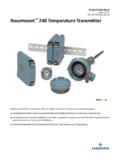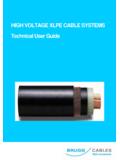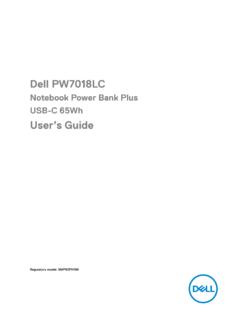Transcription of Standard Operating Procedure: Calibration of Field ...
1 Prepared by: ~ ~ (RobertRei~ ~ Unit) / 'I / Approved by: ,., ; t~ -:x/-u; /~/J/til. - -3 } 2-3 /; 7 John Smaldone, Quality Assurance Unit) f bfp I _/ EQASOP-FieldCalibrat3 Region 1 Calibration of Field Instruments Revision Number: 3 Date: June 3, 1998 Revised March 23, 2017 Page I of 18 Standard Operating PROCEDURE Calibration OF Field INSTRUMENTS (temperature, pH, dissolved oxygen, conductivity/specific conductance, oxidation/reduction potential [ORP], and turbidity) Quality Assurance Unit Environmental Protection Agency - Region 1 11 Technology Drive North Chelmsford, MA 01863 The controlled version of this document is the electronic version viewed on-line only. If this is a printed copy of the document, it is an uncontrolled version and may or may not be the version currently in use. This document contains direction developed solely to provide guidance to Environmental Protection Agency (EPA) personnel.
2 EPA retains the discretion to adopt approaches that differ from these procedures on a case-by-case basis. The procedures set forth do not create any rights, substantive or procedural, enforceable at Jaw by party to litigation with EPA or the United States. 3/l3/J7 rlate ' EQASOP-FieldCalibrat3 Region 1 Calibration of Field Instruments Revision Number: 3 Date: June 3, 1998 Revised March 23, 2017 Page 2 of 18 Revision Page Date Rev Summary of changes Sections # 6/03/98 1 Draft 01/19/10 2 Finalized 3/23/17 3 Updated All sections EQASOP-FieldCalibrat3 Region 1 Calibration of Field Instruments Revision Number: 3 Date: June 3, 1998 Revised March 23, 2017 Page 3 of 18 Table of Contents SCOPE AND APPLICATION .. 4 HEALTH AND SAFETY WARNINGS .. 4 4 FREQUENCY OF 5 Calibration 5 6 pH (electrometric).
3 7 DISSOLVED 8 SPECIFIC 10 OXIDATION/REDUCTION POTENTIAL (ORP) .. 12 13 POST Calibration CHECK .. 14 DATA MANAGEMENT AND RECORDS 15 REFERENCES .. 15 INSTRUMENT Calibration 17 OXYGEN SOLUBILITY AT INDICATED 18 EQASOP-FieldCalibrat3 Region 1 Calibration of Field Instruments Revision Number: 3 Date: June 3, 1998 Revised March 23, 2017 Page 4 of 18 SCOPE AND AP PLICATION The purpose of this Standard Operating procedure (SOP) is to provide a framework for calibrating Field instruments used to measure water quality parameters for groundwater and surface water. Water quality parameters include temperature, pH, dissolved oxygen, specific conductance, oxidation/reduction potential [ORP], and turbidity. This SOP supplements, but does not replace, EPA analytical methods listed in 40 CFR 136 and 40 CFR 141 for temperature, dissolved oxygen, conductivity/specific conductance, pH and turbidity.
4 This SOP is written for instruments that measure temperature, pH, dissolved oxygen, specific conductance, turbidity, and/or oxidation/reduction potential [ORP] and the probe readings for pH, dissolved oxygen, and specific conductance are automatically corrected for temperature. For groundwater monitoring, the instrument must be equipped with a flow-through-cell and the display/logger or computer display screen needs to be large enough to simultaneously contain the readouts of each probe in the instrument. Turbidity is measured using a separate instrument. It must not be measured in a flow-through-cell because the flow-through-cell acts as a sediment trap. This procedure is applicable for use with the EPA Region 1 Low Stress (low flow) Purging and Sampling Procedure for the Collection of Ground Water Samples from Monitoring Wells. HEALTH AND SAFETY WARNINGS Read all labels on the standards and note any warnings on the labels.
5 Wear appropriate personal protection equipment ( , gloves, eye shields, etc.) when handling the standards. If necessary, consult the Safety Data Sheets (SDS) for additional safety information on the chemicals in the standards. GENERAL All monitoring instruments must be calibrated before they are used to measure environmental samples. For instrument probes that rely on the temperature sensor (pH, dissolved oxygen, specific conductance, and oxidation/reduction potential [ORP]), each temperature sensor needs to be checked for accuracy against a thermometer that is traceable to the National Institute of Standards and Technology (NIST). Before any instrument is calibrated or used to perform EQASOP-FieldCalibrat3 Region 1 Calibration of Field Instruments Revision Number: 3 Date: June 3, 1998 Revised March 23, 2017 Page 5 of 18 environmental measurements, the instrument must stabilize (warm-up) according to manufacturer's instructions and must have no air bubbles lodged between the probe and probe guard.
6 Most projects will require at least two standards to bracket the expected measurement range. This means that one Standard is less than the expected value and one is higher. When an environmental sample measurement falls outside the Calibration range, the instrument must be re-calibrated to bracket the new range before continuing measurements. Otherwise, the measurements that are outside the Calibration range will need to be qualified. This SOP requires that the manufacturer s instruction manual (including the instrument specifications) accompany the instrument into the Field . FREQUENCY OF Calibration At a minimum, the instrument is calibrated prior to use on the day the measurements are to be performed. A post Calibration check at the end of the day is performed to determine if the instrument drifted out of Calibration . Some projects may require more frequent Calibration checks throughout the day in addition to the check at the end of the day.
7 For these checks, the instrument can be recalibrated during the day if the instrument drifted out of Calibration and only the data measured prior to the check would need to be qualified. The Calibration /post Calibration data information is recorded in Table 1. Instruments ( , sonde) that monitor continuously over a period of time are calibrated before deployment. When these instruments are recovered, the Calibration is checked to determine if any of them drifted out of Calibration . Some instruments lose their Calibration criteria when they are turned off. Those instruments can either be left on all day (battery dependent) or calibrated at each sampling location. Ideally, the temperature of the standards should be close to the temperature of the ambient water that is being measured. Calibration PROCEDURES Prior to Calibration , all instrument probes and cable connections must be cleaned and the battery EQASOP-FieldCalibrat3 Region 1 Calibration of Field Instruments Revision Number: 3 Date: June 3, 1998 Revised March 23, 2017 Page 6 of 18 checked according to the manufacturer s instructions.
8 Failure to perform these steps (proper maintenance) can lead to erratic measurements. If a multi-probe instrument is to be used, program the instrument to display the parameters to be measured ( , temperature, pH, percent dissolved oxygen, mg/L dissolved oxygen, specific conductance, and ORP). The volume of the Calibration solutions must be sufficient to cover both the probe and temperature sensor (see manufacturer s instructions for the volume to be used). Check the expiration date of the standards. Do not use expired standards. All standards are stored according to manufacturer instructions. TEMPERATURE Most instrument manuals state there is no Calibration of the temperature sensor, but the temperature sensor must be checked to determine its accuracy. This accuracy check is performed at least once per year and the accuracy check date/information is kept with the instrument. If the accuracy check date/information is not included with the instrument or the last check was over a year, the temperature sensor accuracy needs to be checked at the beginning of the sampling event.
9 If the instrument contains multiple temperature sensors, each sensor must be checked. This procedure is not normally performed in the Field . If the instrument is obtained from a rental company, the rental company should perform the Calibration check and include with the instrument documentation that it was performed. Verification Procedure 1. Fill a container with water and adjust the water temperature to below the water body s temperature to be measured. Use ice or warm water to adjust the temperature. 2. Place a thermometer that is traceable to the National Institute of Standards and Technology (NIST) and the instrument s temperature sensor into the water. Wait for both temperature readings to stabilize. 3. Compare the two measurements. The instrument s temperature sensor must agree with the reference thermometer measurement within the accuracy of the sensor ( , C). If the measurements do not agree, the instrument may not be working EQASOP-FieldCalibrat3 Region 1 Calibration of Field Instruments Revision Number: 3 Date: June 3, 1998 Revised March 23, 2017 Page 7 of 18 properly and the manufacturer needs to be consulted.
10 4. Adjust the water temperature to a temperature higher than the water body to be measured. 5. Compare the two measurements. The instrument s temperature sensor must agree with the reference thermometer measurement within the accuracy of the sensor ( , C). If the measurements do not agree, the instrument may not be working properly and the manufacturer needs to be consulted. pH (electrometric) The pH of a sample is determined electrometrically using a glass electrode. Choose the appropriate buffered standards that will bracket the expected values at the sampling locations. If the water body s pH is unknown, then three standards are needed for the Calibration : one close to 7, one at least two pH units below 7, and the other at least two pH units above 7. Instruments that will not accept three standards will need to be re-calibrated if the water sample s pH is outside the initial Calibration range described by the two standards.













